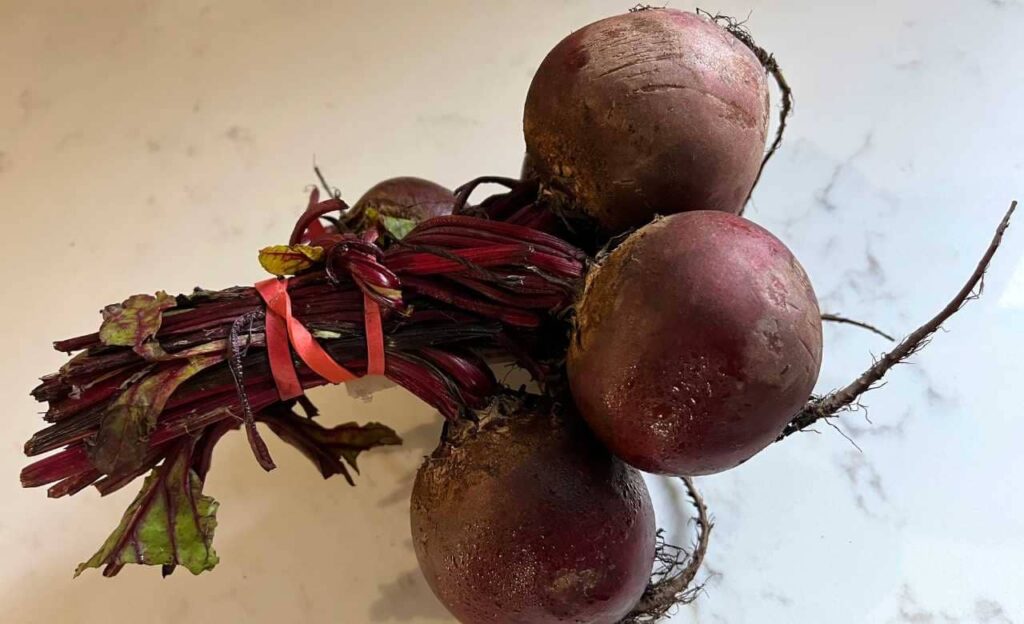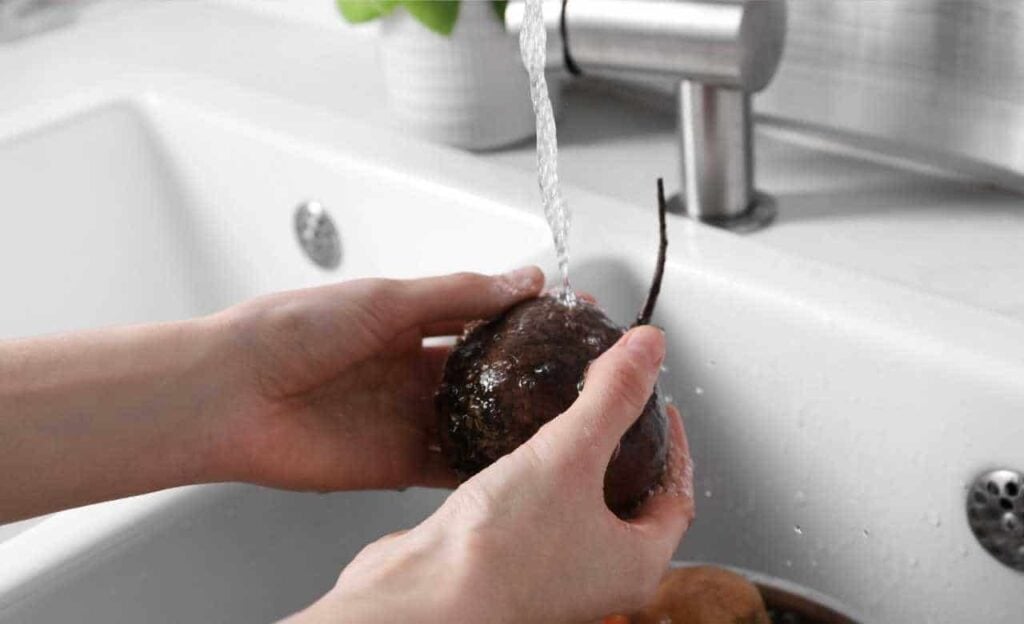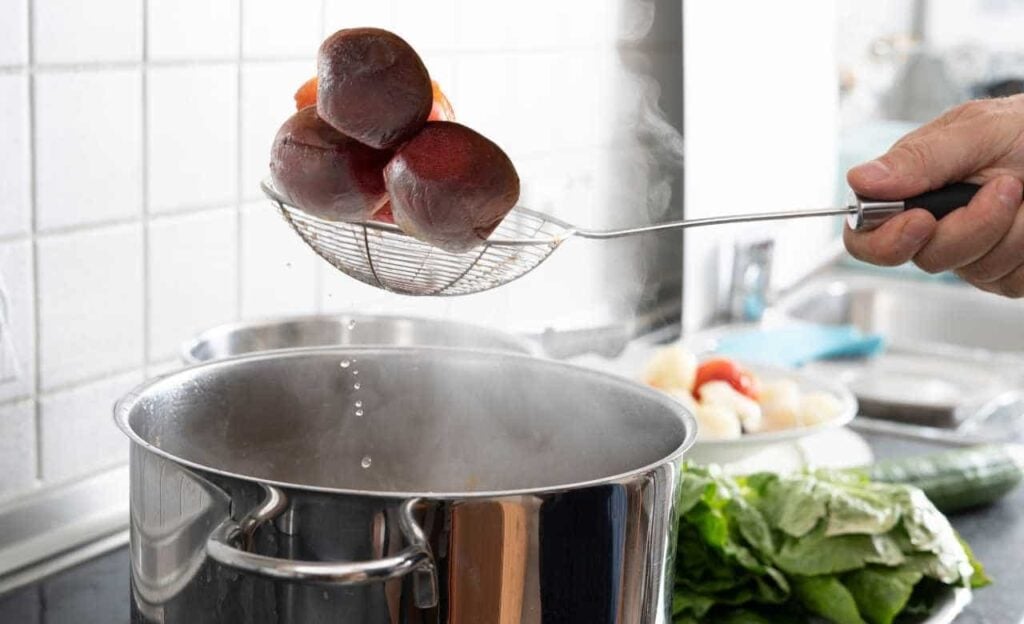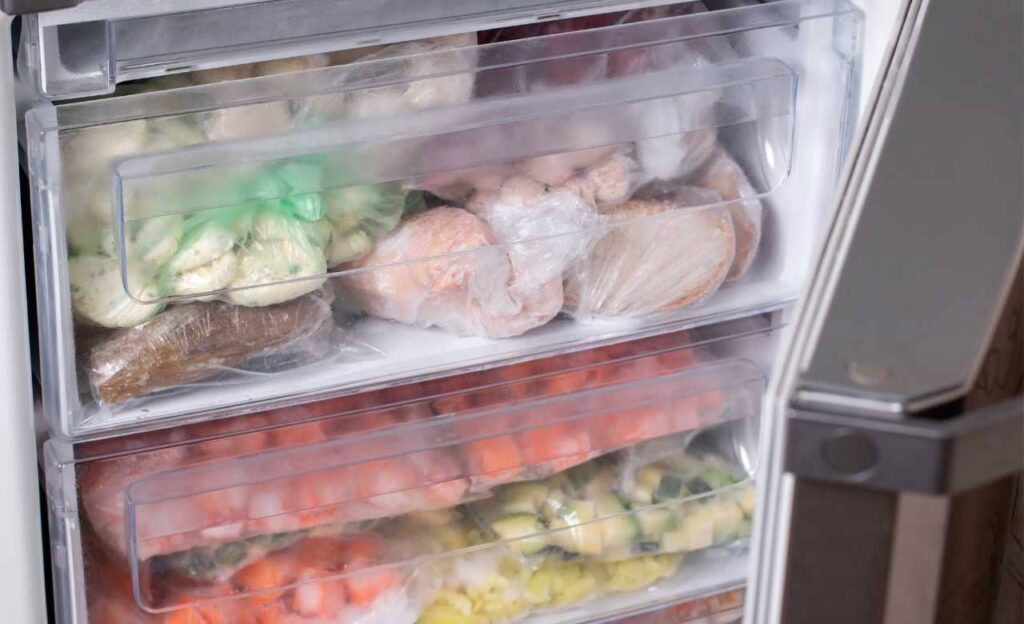Freezing beetroot is a simple way to preserve its rich flavor and nutrients for later use in salads, soups, and smoothies. In this post, I’ll walk you through the steps to freeze beetroot, so you can enjoy this vibrant vegetable anytime!

Jump to:
- Is It Ok to Freeze Beets?
- Should Beets Be Frozen Raw or Cooked?
- Do Frozen Beets Get Mushy?
- How to Freeze Beetroot in the Freezer?
- How Do You Thaw Frozen Beets?
- How Long Can Fresh Beets Be Frozen?
- Do Beets Lose Nutrients When Frozen?
- What Can You Use Frozen Beetroot For?
- Wrapping Up
- Check Out These Easy Dinner Ideas:
Is It Ok to Freeze Beets?
Yes, it's perfectly okay to freeze beets. If you have too many beets and can't use them all before they spoil, freezing small beets is an excellent way to preserve them for future use.
Freezing beets can maintain their nutritional value and flavor. So, whenever you're ready, you can defrost and use them in your favorite recipes without any significant loss in quality.
Should Beets Be Frozen Raw or Cooked?
Freezing beets is a fantastic method to preserve their vibrant color and earthy flavor.
While there is a debate on whether it's better to freeze them raw or fully cooked, most sources suggest that it's best to cook the beets first if you plan to freeze them.
Cooking beets before freezing can help retain vitamins and nutrients while preserving their color.
On the other hand, raw beets, especially when frozen whole, can turn grainy in texture. However, raw beets can be frozen in soups and borscht if chopped into small pieces.
Can I Freeze Cooked Beets Whole?
Yes, you can freeze cooked beets whole. This method can help beets to maintain their taste and nutritional value for longer.
However, ensure they are entirely cooled after cooking before you freeze them. Also, peeling the beets before freezing is generally advised, as the skin can toughen during the freezing and reheating.
With the correct procedure, your frozen cooked beets can be securely stored for up to a year.

Do Frozen Beets Get Mushy?
Frozen beets can become mushy if not prepared and stored correctly. Raw beets get soggy when frozen and thawed, so cooking them before freezing is a good idea.
Because of their high water content, beets might benefit from vacuum sealing before freezing.
It's also important to note that even properly prepared beets are susceptible to freezer burn.
How to Freeze Beetroot in the Freezer?
You can freeze roasted, boiled beets or steamed beetroot using this method.
Step 1: Choose the Right Beet Variety
Selecting the best beets with smooth skin and no visible blemishes or signs of decay is important.
Young beets are usually sweeter and more tender than their older counterparts, making them an excellent choice for freezing.
The size of the beet doesn't determine its quality but will affect how long you need to both cook and freeze it. Once you've selected it, you can proceed with the necessary steps for freezing.

Step 2: Prepare the Beetroots
Wash your beetroot with a vegetable brush under running water to remove dirt or debris.
Chop the greens off the beets, leaving about an inch of the stems attached, which helps eliminate the beets bleeding color while cooking.
Keeping the greens attached to the beets will accelerate their spoilage.

Step 3: Cook the Beetroots
Cook the whole beets in a large pot of boiling water until tender.
The cooking time for your beets will vary between 30 minutes for smaller beets, for medium beets 45 to 50 minutes and 1 hour for larger beets.
You can check their doneness by poking them with a fork. If the fork goes in easily, they're done.

Step 4: Cool and Peel the Beetroots
After cooking the red beets, strain them and quickly submerge them in a bowl filled with ice water.
This will stop the cooking process and make them easier to handle. Once they are cool to the touch, you can peel off the skin using a sharp knife or your fingers.

Step 5: Slice or Dice the Beetroots
With your beetroots now peeled, feel free to slice or chop them as desired.
Keep in mind that smaller pieces will freeze more quickly and evenly.

Step 6: Flash Freeze the Beetroots
For optimal results in freezing beetroots, it is recommended to flash-freeze them beforehand to prevent them from clumping together.
For this step, arrange the pieces on a baking tray lined with parchment paper. Make sure they're spread out and not touching each other. Then, place the tray in the freezer for a few hours until the beetroots are frozen successfully.
Step 7: Packing
Finally, transfer the frozen beetroot pieces into plastic freezer bags or containers. Make sure to squeeze out as much air as possible before sealing to prevent freezer burn.
Step 8: Store Beets in Freezer
Label the bags or containers with today's date before returning them to the freezer. When properly stored, frozen beetroot can remain good for up to one year.

Freeze Raw Beets
- Wash and peel the raw beets with a vegetable peeler.
- Cut the raw peeled beets into small pieces, then transfer them into a freezer bag.
- Label the bag with the date and place it in the freezer.
Freeze Roasted Beets
- Begin by washing and tightly wrap each beet in aluminum foil and placing them on a microwave-safe dish.
- Preheat your oven to 400°F. After that, roast the beets until they become soft.
- Once done, allow the beets to cool down to room temperature before you peel them and cut them into your desired size.
- Transfer the roasted beets into a freezer bag, squeeze out as much air as possible, label the bag with the date, and place it in the freezer.
Do Beets Need to Be Blanched?
Blanching beets is a recommended process before freezing them. This method involves boiling water over the beets for two to three minutes. Blanch beets deactivate natural enzymes, helping to preserve their color, texture, and flavor.
However, if you plan to cook and freeze the chopped beets, blanching isn't necessary; they can be frozen raw and still maintain good quality.
Pre-cooking beets, including blanching, is beneficial as it helps retain vitamins and nutrients and preserves their color.
How Do You Thaw Frozen Beets?
Here are methods you can use to thaw frozen beets
1. Thawing at Room Temperature:
Remove your frozen beets from the freezer, ensuring they remain in their packaging to avoid leakage. Place the packaged beets in a bowl or on a plate to catch any liquid that may be frozen beets or released during the thawing process.
To thaw the beets, leave them at room temperature. Depending on their size, they may need a few hours to thaw fully. Remember to check on them from time to time.
Once the beets are thawed, they should be cooked immediately to prevent bacteria from growing.
2. Thawing in the Fridge Overnight:
Transferring your frozen beets into a shallow baking dish or a bowl for this method would be best. The shallow dish allows for more even defrosting.
To protect the beets from absorbing other smells in the fridge and to retain their moisture, it is recommended to cover the dish or bowl with plastic wrap.
Place the dish or bowl in the refrigerator. The beets should be left to thaw overnight. This is a slower process than room temperature thawing, but it is safer because it keeps the thawed beets at a constant, safe temperature.
After the beets have thawed in the fridge overnight, they should be cooked as soon as possible.
3. Thawing in Microwave:
To thaw beets in the microwave, first place them in a microwave-safe dish. Do not use metal or aluminum foil in the microwave.
Set your microwave to the "defrost" setting or 50% power. This lower power level is important to slowly thaw the beets without cooking them.
You should check the beets every minute to ensure they don't start to cook. If the beets become warm, they should be cooled quickly and cooked immediately.
Once completely thawed, the beets should be cooked immediately to prevent any potential bacterial growth.

How Long Can Fresh Beets Be Frozen?
Blanched beets can be frozen and stored for up to a year. The quality can be preserved by securely wrapping and storing it in airtight containers or robust freezer bags.
Raw beets can last up to two weeks in the refrigerator and up to four months if properly stored. Cooked beets, like roasted ones, can last 5-7 days in the fridge and about a week if stored in an airtight container.
They can stay good for 10-14 days, depending on storage conditions.
Please note these are estimated times, and actual shelf life might vary based on initial freshness, storage conditions, and contaminant exposure.

Do Beets Lose Nutrients When Frozen?
From the information gathered, freezing beets might result in some loss of nutrients, particularly vitamin C, which is sensitive to heat and cold.
Nonetheless, most nutrients remain intact, ensuring you still obtain substantial health benefits from consuming frozen beets. Notably, fresh beets are known for their ability to support blood flow because of their high nitrate content.
Therefore, even if there's a slight loss of vitamin C during freezing, the impact on the overall nutritional value is minimal.
What Can You Use Frozen Beetroot For?
Here are some ways you can use frozen beetroot:
- Beet Salad: You can add frozen beets to your favorite salad mix. Defrost them, cut them into slices or cubes, and toss them in. Beets' vibrant color and earthy taste can add a new dimension to your regular salad.
- Roasted Beetroot: Roasting is a great way to use root vegetables. Toss your frozen beetroot in olive oil and your choice of spices, then roast in the oven until they're tender and caramelized and serve as a side dish.
- Beet Juice or Smoothie: Frozen beetroot makes beet juice or smoothies. Mix them with your preferred selection of fruits and vegetables to make a healthy and nourishing drink.
- Pickled Beets: Pickling is another exciting way to use frozen beets. You can pickle them with vinegar, sugar, and spices and use them as a garnish or addition to various dishes.
- Beet Soup: Soups are great for incorporating root vegetables like beetroot. You can make a hearty beet soup or borscht using your frozen beets.
- Beet Hummus: For a twist on traditional hummus, add frozen beets to your chickpeas when making hummus. This will give your hummus a beautiful color and a unique taste.
- Beet Risotto: Adding frozen beets to your risotto can provide a sweet, earthy flavor and a striking color to your dish.
- Beetroot Curry: A staple in many Indian cuisines, beetroot curry is a delicious and healthy dish. Add frozen beets to a mix of spices and other vegetables to create this vibrant dish.
- Beetroot Pasta Sauce: Make a unique pasta sauce using frozen beets. Blend them into a smooth puree, then mix with olive oil, garlic, and your preferred herbs for a tasty and colorful sauce.
- Beetroot Pancakes: For a fun twist on breakfast, incorporate frozen beets into your pancake batter. This will give your pancakes a bright pink color and a slightly sweet flavor.
- Beetroot Stir Fry: Stir fry is a great way to use a variety of vegetables, including frozen beets. Toss them with other veggies and your favorite sauce for an easy meal.
- Beetroot Salsa: For a unique salsa, combine defrosted beets with onions, cilantro, lime juice, and chili peppers. Enjoy it with tortilla chips or to enhance the flavor of tacos or grilled chicken.
Wrapping Up
Thus, freezing beets isn't a complicated process - all it takes is some basic preparation and simple steps. Whether you want to freeze small portions of beets or an entire batch, various methods for thawing and cooking can suit your needs.
Not only does freezing retain the health benefits of cooking and freezing, but it also helps make cooking with beetroot quicker and easier.





Leave a reply